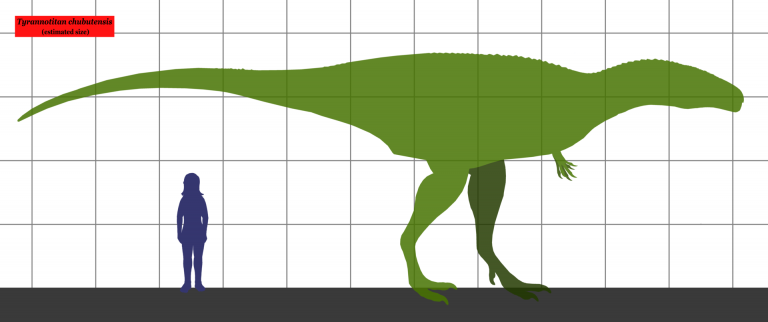Tyrannotitan
Tyrannotitan is a genus of huge bipedal carnivorous dinosaur of the carcharodontosaurid family from the Aptian stage of the early Cretaceous period, discovered in Argentina. It is closely related to other giant predators like Carcharodontosaurus and especially Giganotosaurus as well as Mapusaurus. The name means “Tyrant titan”.

Tyrannotitan is the geologically oldest known giant carcharodontosaurid along with the more basal Acrocanthosaurus from North America (both found in Aptian-age rocks). Unlike known carcharodontosaurids, this animal lacks pneumaticity extending into the sacral and caudal centra. The scapulocoracoid is fused, and much better developed than that of Giganotosaurus carolinii, yet the arm is very small. Most of the shaft of the scapula is missing.
Tyrannotitan chubutensis was described by Fernando E. Novas, Silvina de Valais, Pat Vickers-Rich, and Tom Rich in 2005. The fossils were found at La Juanita Farm, 28 kilometres (17 mi) northeast of Paso de Indios, Chubut Province, Argentina. They are believed to have been from the Cerro Castaño Member, Cerro Barcino Formation (Aptian stage) around 112.2 – 121 million years ago.
One key area of difference between Tyrannotitan and the other currently known carcharodontosaurids is the lack of pneumaticity in the sacral (hip) and caudal (tail) vertebrae. This essentially means that there are no air pockets that could have reduced weight resulting in a solid but heavier skeleton. Interestingly connected to this observation is the fact that a caudal vertebra of Tyrannotitan has a neural spine (the projection top of the vertebra) twice the height of the centrum, the main body of the vertebral bone that articulates with the other vertebra. The dorsal (back) and cervical (neck) vertebra do not display neural spines this high, and with this in mind the tail vertebrae may have had them to support a stronger muscle network that was required to carry the tail high and off the ground in the absence of weight saving features such as pneumaticity.
Tyrannotitan teeth do not seem to be as well developed as those of others of its group such as those seen in Carcharadontosaurus. Tyrannotitan teeth lack the clear curves that facilitate slicing however the general shape makes them part way similar to the teeth of allosaurids like Allosaurus itself. Given that the carcharodontosaurid theropods are thought to be descended from allosaurid theropods, the teeth of Tyrannotitan may represent a transitional form of the teeth from one changing into another.
The length of these animals has been estimated at up to 11.4–12.2 metres (37–40 ft). In 2010, Gregory S. Paul gave higher estimations of 13 metres (43 ft). Its weight has been estimated between 4.9 and 7 tonnes (5.4 and 7.7 short tons).











